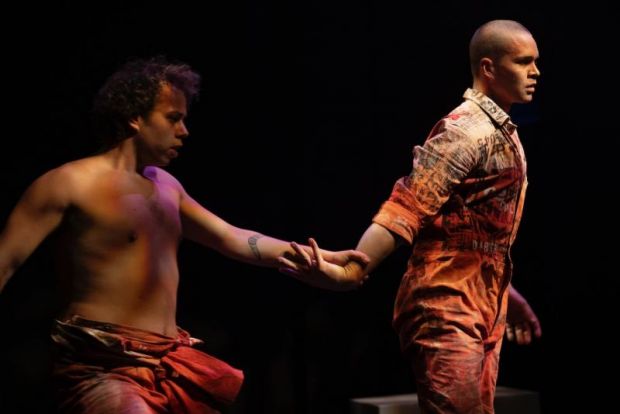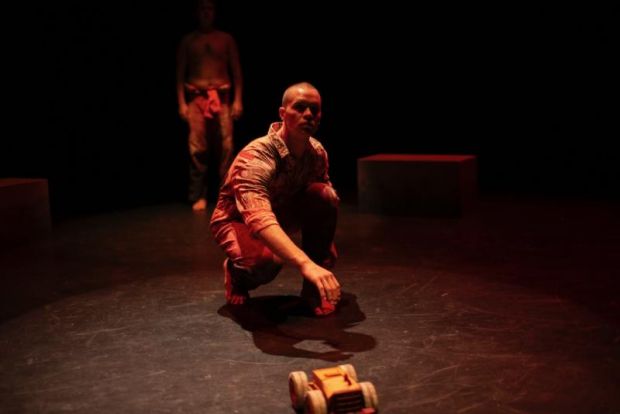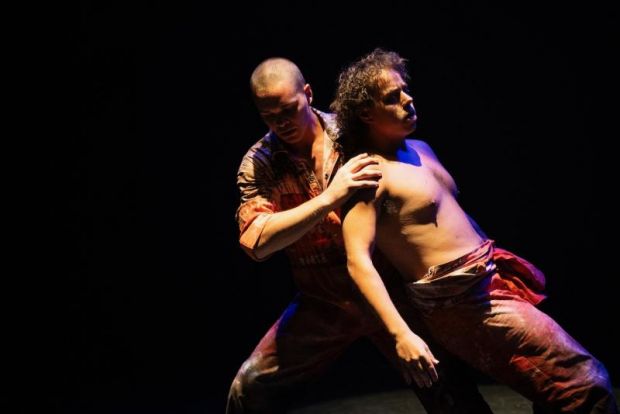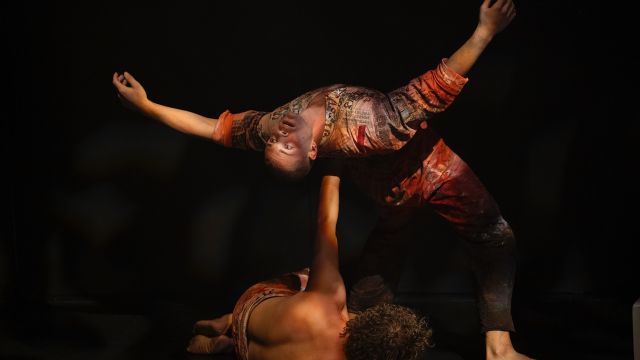The Other Side of Me
“Every morning our people would crush charcoal and mix that with animal fat and smother that all over us, so that when the police came, they could only see black children in the distance. We were told always to be on the alert and, if white people came, to run into the bush or run and stand behind the trees, or else hide behind logs or run into culverts and hide. Often the white people – we didn't know who they were – would come into our camps. And if the Aboriginal group was taken unawares, they would stuff us into flour bags and pretend we weren’t there. We were told not to sneeze. We knew if we sneezed and they knew that we were in there bundled up, we’d be taken away.”
— Bringing them Home, Confidential evidence 681. Woman ultimately surrendered at 5 years of age to a church mission for schooling.
Inspired by a collection of letters written by a young Aboriginal man to Laura Fish, a Black British woman, the helpful program notes inform us, “The Other Side of Me explores the story of one of Australia’s ‘Stolen Generations’. Laura first met him in the 1990s. During their four-year correspondence, he explained how being removed from his First Nations family in Australia to be brought up in the English countryside created a profound sense of dislocation. There was the English side he knew, and the Indigenous heritage from which he was taken.

“Now, nearly 30 years later, The Other Side of Me tells the extraordinary story of his bitter search for identity. He died while being restrained by the police in the late 1990s. The young man’s story puts into stark relief Australian federal and state government policies from 1910 until the 1970s to wrongly remove children of Australian Aboriginal and Torres Strait Islander descent from their families and culture and to integrate First Nations people into white society. His experience in England resonates with international debates concerning cultural genocide, displacement, visibility and perspective, national and cultural heritage, ‘race’ and identity.”
So how, as a white, middle-class, middle-aged, privileged, and moderately well-educated man do I begin to write about my experience of this performance? The starting point might well be the finishing point – when I was so emotionally overwhelmed as it reached its climax that as soon as it ended, I hurriedly left the auditorium a sobbing mess … undone, ultimately, by Ms Rhodham’s choice to gradually fill the back wall with an archival photograph of the smiling faces of Aboriginal children in the final moments of the performance. Every one of Ms Rhodham’s choices about how to visually enhance, power and punctuate the performance remain quite possibly the most creatively intelligent use of the medium I’ve yet experienced in the theatre.
Mr Pearson’s soundscape, with contributions from German-British composer Max Richter, powers the work with a plaintive restlessness … an involving soundscape that is much more concerned with the elusiveness of the perfect environment and ecology, than conventional storytelling. Mr Mercurio beautifully balances what we expect and need to see within a dreamscape, combining artful shadows, accents and effects to illuminate the performers as if they were dancing in a dream … a distant yet immediate recollection … or a nightmare.

Mr Lang’s choreography, from the first unexpected moment, denies and demolishes stereotype, archetype, convention, and expectation in a mesmerising work that is performed with dazzling virtuosity by Alexander Abbot and 'Cheeky' Chandler Connell. Gradually rising from exceptional floor work, the men explore extensions of masculinity, muscle, and a stark futility, intelligently served by Ms Irwin’s boilersuit/prison uniforms, decorated with numbers and letters with a shared history of their own. At times mirroring each other, there is the lightness of touch, of being … trepidation … a painful fear and reluctance to be open to trust … themselves and each other. Suspicion, faith, and that ever-elusive trust drive this work, but it is clear Mr Abbott and Mr Connell instinctively trust the physical and emotional complexity of the work, and themselves within the bringing of it to life. As mirrors of each other, and with little, if any eye contact, they reflect shared but very different experiences that are united by immense longing and pain, loneliness, and the search for joy and meaning, represented throughout the work by exceptional extensions, flinching, angular isolation and individuality, punctuated by liberating grand, sweeping gestures and brilliantly balanced and adventurous lifts.
As the performance reached its crescendo, astonishing work up and off the wall, resulted in me holding my breath, unable to believe Mr Connell’s distance from the floor, or the dancers’ individual and combined strength, discovered only through the desperation of clambering to be free – feet first and upside down. Faces are smeared with white ochre, words appear on the wall, and our emotions are stretched impossibly taut, like elastic, before we are lovingly released back into our journey … with them, with each other, and then suddenly, without both.

Days later, as I was still considering how I might approach sharing this experience with you with some of my critical faculties still intact, I recalled the final lines of the late Brian Friels’ masterpiece, Dancing at Lughnasa. I was considering, given that the inspiration for The Other Side of Me was words, why this work might best be served by dance and not spoken word. The miraculous, unforgettable achievement that is The Other Side of Me is perfectly matched to the late Brian Friels’ equally unforgettable final words for his Dancing at Lughnasa:
“Dancing as if language had surrendered to movement – as if this ritual, this wordless ceremony, was now the way to speak, to whisper private and sacred things, to be in touch with some otherness. Dancing as if the very heart of life and all its hopes might be found in those assuaging notes and those hushed rhythms and in those silent and hypnotic movements. Dancing as if language no longer existed because words were no longer necessary.”
Geoffrey Williams
Images: Alexander Abbot and 'Cheeky' Chandler Connell in The Other Side of Me. Photography by Paz Tassone.
If you need to talk to someone:
Lifeline on 13 11 14
Kids Helpline on 1800 551 800
MensLine Australia on 1300 789 978
Suicide Call Back Service on 1300 659 467
Beyond Blue on 1300 22 46 36
Headspace on 1800 650 890
Find out more about the 2023 Darwin Festival program here:
Subscribe to our E-Newsletter, buy our latest print edition or find a Performing Arts book at Book Nook.

